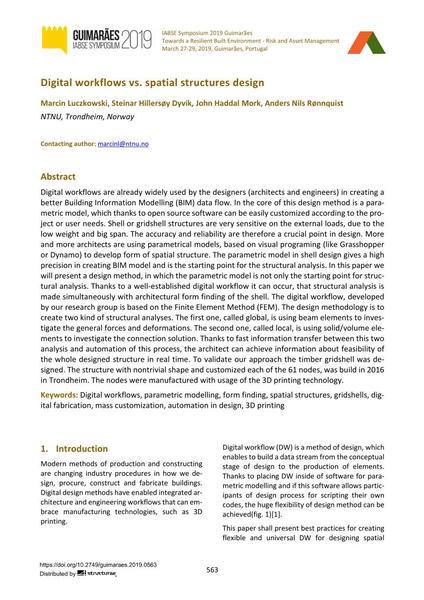Digital workflows vs. spatial structures design

|
|
|||||||||||
Bibliografische Angaben
| Autor(en): |
Marcin Luczkowski
(NTNU, Trondheim, Norway)
Steinar Hillersøy Dyvik (NTNU, Trondheim, Norway) John Haddal Mork (NTNU, Trondheim, Norway) Anders Nils Rønnquist (NTNU, Trondheim, Norway) |
||||
|---|---|---|---|---|---|
| Medium: | Tagungsbeitrag | ||||
| Sprache(n): | Englisch | ||||
| Tagung: | IABSE Symposium: Towards a Resilient Built Environment Risk and Asset Management, Guimarães, Portugal, 27-29 March 2019 | ||||
| Veröffentlicht in: | IABSE Symposium Guimarães 2019 | ||||
|
|||||
| Seite(n): | 563-569 | ||||
| Anzahl der Seiten (im PDF): | 7 | ||||
| DOI: | 10.2749/guimaraes.2019.0563 | ||||
| Abstrakt: |
Digital workflows are already widely used by the designers (architects and engineers) in creating a better Building Information Modelling (BIM) data flow. In the core of this design method is a para- metric model, which thanks to open source software can be easily customized according to the pro- ject or user needs. Shell or gridshell structures are very sensitive on the external loads, due to the low weight and big span. The accuracy and reliability are therefore a crucial point in design. More and more architects are using parametrical models, based on visual programing (like Grasshopper or Dynamo) to develop form of spatial structure. The parametric model in shell design gives a high precision in creating BIM model and is the starting point for the structural analysis. In this paper we will present a design method, in which the parametric model is not only the starting point for struc- tural analysis. Thanks to a well-established digital workflow it can occur, that structural analysis is made simultaneously with architectural form finding of the shell. The digital workflow, developed by our research group is based on the Finite Element Method (FEM). The design methodology is to create two kind of structural analyses. The first one, called global, is using beam elements to inves- tigate the general forces and deformations. The second one, called local, is using solid/volume ele- ments to investigate the connection solution. Thanks to fast information transfer between this two analysis and automation of this process, the architect can achieve information about feasibility of the whole designed structure in real time. To validate our approach the timber gridshell was de- signed. The structure with nontrivial shape and customized each of the 61 nodes, was build in 2016 in Trondheim. The nodes were manufactured with usage of the 3D printing technology. |
||||
| Stichwörter: |
Formgebung 3D-Drucken 3D-Druck Gitterschalen
|
||||
